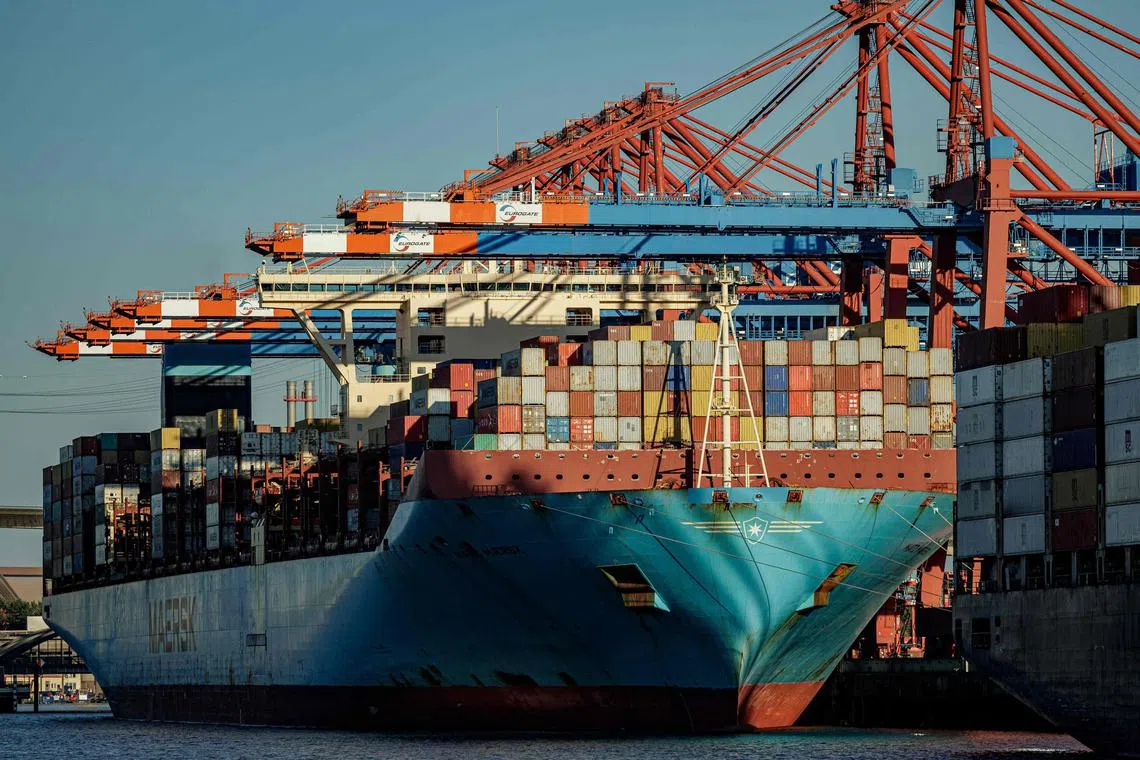Container rates soar on concerns of prolonged Red Sea disruption
Sign up now: Get ST's newsletters delivered to your inbox

Most container ships are avoiding the Suez Canal - a shortcut from Asia to Europe for almost one-third of container ship cargo.
PHOTO: AFP
Follow topic:
LONDON/LOS ANGELES - Container shipping rates for key global routes have soared this week, with US and UK air strikes on Yemen
US and British warplanes, ships and submarines launched dozens of strikes across Yemen overnight in retaliation against Iran-backed Houthi forces for attacks on Red Sea shipping,
Most container ships are avoiding the nearby Suez Canal – a shortcut from Asia to Europe for almost one-third of container ship cargo. The latest escalation fuelled worries that oil tankers and bulk carriers that ferry vital commodities like grain could also avoid the shortcut, risking a new round of global inflation.
The benchmark Shanghai Containerised Freight Index was up over 16 per cent week-on-week to 2,206 points on Jan 12. The index, which measures non-contract “spot” rates for container shipments out of China’s ports, has gained 114 per cent since mid-December.
Rates on the Shanghai-Europe route rose 8.1 per cent to US$3,103 (S$4,134) per 20-foot container on Jan 12 from a week earlier, while the rate for containers to the unaffected US West Coast soared 43.2 per cent to US$3,974 per 40-foot containers week on week, leading ship broker Clarksons said on Jan 12.
“The longer this crisis goes on, the more disruption it will cause to ocean freight shipping across the globe and costs will continue to rise,” Mr Peter Sand, chief analyst at freight platform Xeneta, said on Jan 12.
“We are looking at months rather than weeks or days before this crisis reaches any kind of resolution,” he said, referring to the growing conflict.
Major container ship owners such as Maersk and Hapag-Lloyd have switched Suez Canal-bound ships to the longer route around Africa’s Cape of Good Hope. This has disrupted complex vessel schedules, delayed cargo and sent shipping costs sharply higher.
It is likely oil tankers and other types of ships will follow in higher numbers in the near term, Jefferies analyst Omar Nokta said in a note on Jan 12.
Major importers already are reporting fallout from the Red Sea crisis.
Tesla on Jan 11 said it would temporarily suspend most car production at its factory near Berlin after Red Sea-related diversions led to a lack of components. Global furniture seller Ikea also warned of potential product delays.
“The price of a vast range of goods threatens to march upwards again,” said Ms Susannah Streeter, head of money and markets, Hargreaves Lansdown.
Rerouting a ship around Africa adds roughly US$2 million in fuel costs for each Asia-Northern Europe round-trip. Carriers are recouping that and rolling out other surcharges.
Container ship operators are pulling vessels into the most affected European and Mediterranean trade lanes to compensate for longer sailing times on rerouted ships. That is reducing available vessel space for cargo moving on Transpacific and North-South routes and sending costs on those trade lanes higher, Jefferies analyst Nokta said.
At the same time, customers told Reuters vessel operators are rationing less expensive, contract-rate space and forcing a portion of their shipments into the pricier spot market.
Meanwhile, the China Containerised Freight Index had its biggest jump on record on Jan 12 in both nominal and percentage terms. The CCFI, which measures both spot and liner contracts, jumped 21.7 per cent to reach 1,140 points, Mr Nokta said. REUTERS

